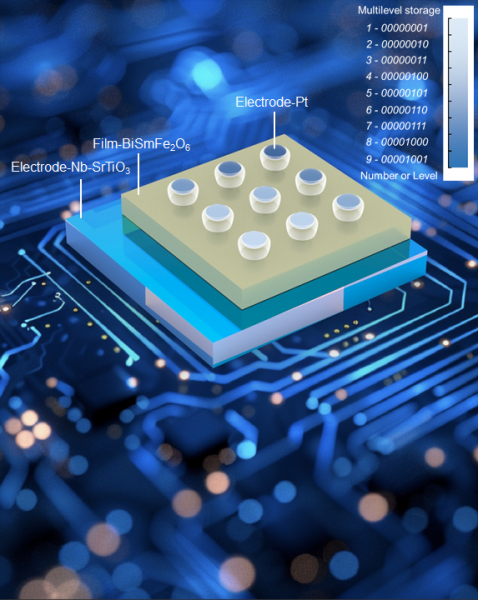Semiconductor for next-generation information storage devices
Scientists from the University of Science and Technology Beijing (USTB) and the Centro de Física de Materiales (CFM, CSIC-UPV/EHU) enhanced the magnetic and electronic properties of bismuth ferrite by modifying its atomic structure, paving the way for low-power, high-capacity memory devices. Their discoveries were published in Nature Communications and Science Advances.
References:

Figure 1. Switch the polarization in BiFeO3 thin film using an electric field. In both models, the electrodes in golden are used to apply the electric field.
Bismuth ferrite (BiFeO3), a semiconductor, exhibits spontaneous electric polarization due to the off-centering between positive and negative charge centers. The polarization can be switched by electric field, leading to two stable states that can be encoded “0” and “1” states (see Fig. 1) In random access memory based on such materials, information remains safely stored even if there is a break in the power supply. On contrary, in dynamic random-access memory widely used in computers, information will be completely lost if electricity is turned off.
Moreover, in BiFeO3, the electric polarization can be coupled with its magnetic properties. This coupling makes BiFeO3-based devices promising for using less power and storing more information than conventional hard disks. However, the magnetism in BiFeO3 thin films is usually very weak, making the coupling unfeasible.
In a recent work at Nature Communications, scientists from the University of Science and Technology Beijing in China (USTB) and the Centro de Física de Materiales (CFM, CSIC-UPV/EHU) in Spain found that by replacing some of the oxygen in the material BiFeO3 with sulfur, they could make its magnetic strength up to 62 times stronger. One of the lead researchers Linxing Zhang at USTB explained that adding sulfur changes the material’s microstructure and the way its iron atoms bond with nearby atoms, which greatly increases its magnetism. This enhanced magnetism of BiFeO3 opens up more opportunities for scientists to improve its magneto-electric coupling, paving the way for the development of low-power memory devices.
In another closely related work appearing at Science Advances, the same lead scientists Linxin Zhang from USTB and Yue-Wen Fang from CFM developed a multifunctional material based on BiFeO3, named Bi0.5Sm0.5FeO3. They found that by creating oxygen vacancies in the material, they can adjust the internal strain in the material chemically to change its electronic and optical properties.
In particular, the switchable open-circuit voltage is increased to 1.56 V from 0.50 V for Pt/BiSmFe2O6/Nb-SrTiO3 devices, which is the highest in single-layer perovskite-based ferroelectric photovoltaic perpendicular devices under white light-emitting diode irradiation. Based on this device, the scientists showed that the combined control of light power density and polarization voltage might enable the device to read and write digital data from at least 00 to 99 in binary, implying the non-volatile multi-level storage (Fig. 2 demonstrates a device model).

Figure 2. The BiSmFe2O6-based storage device with non-volatile multi-level storage by employing electric field and illumination. The color bar shows different illumination power.
“Bismuth ferrite has been studied for over 50 years. Despite extensive research, there are still many mysterious issues I do not understand due to the complex interactions between its electrical charges, magnetic properties, and structure. My collaborator, Linxing, is a highly creative solid-state chemist who has pioneered a novel approach called anion engineering. While many researchers continue to focus on modifying metal ions, our two reports have shown that altering negatively charged ions can enhance the material’s multiple functions. This breakthrough could lead to cheaper and more effective applications in information storage devices.” CSIC scientist Yue-Wen Fang is optimistic about the future uses of bismuth ferrite.



